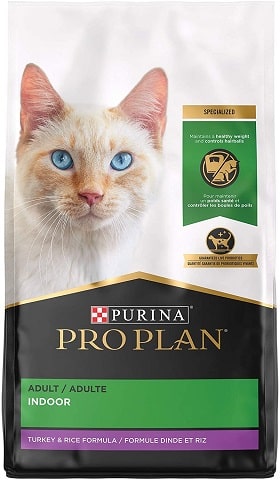Purina is a company that makes a wide range of pet food products for cats and dogs, and we are going to take a look at two of their most popular cat food lines, Purina Pro Plan and Purina One, to see which one is better. We did the work and compared the two, and we’ll let you know about our results here.
Keep reading while we compare ingredients, cost, varieties, and more to determine which is the best overall.
A Sneak Peek at the Winner: Purina One
| Image | Product | Details | ||
|---|---|---|---|---|
| Our Favorite |

|
Purina ONE True Instinct High Protein |
|
CHECK PRICE |
| Runner Up |

|
Purina Pro Plan Indoor Care Hairball Control |
|
CHECK PRICE |
We went with Purina One as the winner because it contains higher quality ingredients on average. However, we should point out that the Purina Pro Plan has more than three times the number of recipes, and it’s more than possible to find a few that are as good as the Purina One. Keep reading while we look at the various ingredients as well as other differences between the two varieties.
About Purina Pro Plan
Purina Pro Plan uses a patented recipe that reduces cat allergens. According to their website, the Purina Pro Plan can reduce the allergens in cat hair and dander by 47% after 3 weeks. It’s available in wet and dry food and typically has a high protein level. Most of the dry food stays above 40%, and most of the wet food is above 45%.
All of the recipes we checked had whole meat like chicken, turkey, beef, or fish listed as the first ingredient. Most recipes also had reduced fat content over other brands, helping reduce the risk of heart disease and other problems. Pro Plan’s recipes were also slightly lower in calories than the average brand, which can help keep weight gain under control.
Some of the recipes are higher than average in carbohydrates. Cats are carnivorous and do not need carbs in their diet, and adding them will only lead to weight gain. Almost every recipe we checked had corn, soy, or both listed in the ingredients. Both corn and soy are often genetically modified, and they are nothing more than empty calories and not part of your cat’s natural diet.
The corn often leads to digestive troubles in some cats, though many do enjoy it. One other ingredient in many recipes is meat by-products. Meat by-products are dried and ground-up meat that producers add to food to increase the protein level. It’s not inherently bad, but much of it comes from countries with lower pet food standards than America, and it’s lower quality meat than chicken, turkey, or beef.
- Reduces allergens
- Higher protein level
- Reduced fat content
- Whole meat is the first ingredient
- Some can be high in carbs
- Contains soy and corn
- Meat by-products
About Purina One
Purina One guarantees you will notice your pet is more energetic with a shinier coat and brighter eyes. Most recipes that we looked at contained less fat than the average brand. The wet food has more fiber than average, while dry food has less.
Fiber is important for a well-balanced digestive system, and if your cat doesn’t get enough, it can lead to constipation and other health problems. We found that most of the recipes have fewer calories than typical food, and most recipes have high-quality ingredients like real fruits and vegetables, and few contain corn and soy, though some do.
The downside to Purina One is that it typically doesn’t have as much protein as the Purina Pro Plan. These recipes are typically at about 35% for dry food and 45% for wet. We also found several recipes that have corn or other non-meat listed as the top ingredient.
- Low fat
- Fewer bad ingredients
- Low calories
- Not as much protein
- Fewer recipes have whole meat as the first ingredient
The 3 Most Popular Purina Pro Plan Cat Food Recipes
1. Purina Pro Plan Indoor Care Hairball Control Adult Dry Cat Food & Wet Cat Food

Purina Pro Plan Indoor Care Hairball Control Adult Dry Cat Food & Wet Cat Food contains turkey as its first ingredient, and it has a unique formula that reduces hairballs. It has a good amount of protein for dry food at 40%, and it has plenty of natural fiber to help support a balanced digestive system.
The downside of Purina Pro Hairball Control is that it contains corn as well as chicken meal. Also, a few of our cats didn’t like it.
- Turkey first ingredient
- Hairball formula
- 40% protein
- Natural fiber
- Contains corn
- Some cats don’t like it
2. Purina Pro Plan Urinary Tract Health, High Protein Adult Dry Cat Food & Wet Cat Food

Purina Pro Plan Urinary Tract Health, High Protein Adult Dry Cat Food & Wet Cat Food is a special formula food that helps protect your cat from urinary tract infections. It has 25 essential vitamins and minerals that will help boost your cat’s immune system and help them develop properly.
The biggest downside to Purina Pro Plan Urinary Tract Health is that many of our cats didn’t like it, and at only 12% protein, it is only suitable for cats with an infection. It also has a meat by-product as its first ingredient.
- Supports urinary tract health
- Boosts the immune system
- 25 essential vitamins and minerals
- Meat by-product first ingredient
- Some cats don’t like it
3. Purina Pro Plan With Probiotics High Protein Adult Dry Cat Food

Purina Pro Plan With Probiotics High Protein Adult Dry Cat Food is another hard food. This one contains a probiotic fortification to help balance your pet’s digestive system, which will help relieve diarrhea and constipation. Probiotics can also help build the immune system. It also has healthy omega fats, which help your cat produce a shiny coat, among other benefits, and there are no harmful chemical preservatives.
What we didn’t like about Purina Pro Plan with Probiotics was that, like many other recipes, it has meat by-products. It also has a strong odor, and people reported their cats didn’t like it.
- Chicken first ingredient
- Omega fats
- Contains probiotics
- 40% protein
- No chemical preservatives
- Some cats don’t like
- Smells bad
- Contains meat by-product
The 3 Most Popular Purina One Cat Food Recipes
1. Purina ONE True Instinct High Protein, Natural Wet Cat Food in Sauce or Gravy

Purina ONE True Instinct High Protein, Natural Wet Cat Food in Sauce or Gravy features tuna as its first ingredient, and it also has chicken and liver for added protein. Each can will have at least 35% protein, and it also contains taurine, an important nutrient found only in animal proteins.
Unfortunately, Purina One True Instinct contains meat by-products, and the company also seems to change the formula often, which can upset finicky cats.
- Tuna first ingredient
- Contains chicken and liver
- Contains taurine
- 35% protein
- Contains meat by-product
- Changing formula
2. Purina ONE Indoor Advantage Hairball Control Dry Cat Food & Wet Cat Food

Purina ONE Indoor Advantage Hairball Control, Natural Adult Dry Cat Food & Wet Cat Food features turkey as its top ingredient. It’s low in carbohydrates, promoting a healthy weight, and it also contains anti-hairball ingredients and antioxidants.
What we didn’t like about Indoor Advantage is that it contains poultry by-products. Our cats enjoyed this recipe, but it caused bad-smelling gas.
- Turkey first ingredient
- Promotes a healthy weight
- Hairball formula
- Antioxidants
- Contains poultry by-product
- Bad smelling stools
- Causes gas
3. Purina ONE Tender Selects Blend Adult Dry Cat Food

Purina ONE Tender Selects Blend Adult Dry Cat Food features salmon as its top ingredient. It also contains tuna and other helpful ingredients that provide your pet with plenty of omega fats and antioxidants to boost the immune system. Crunchy kibble will help scrub tartar and plaque from your pet’s teeth, while tender morsels will supply extra flavor.
The downside to Tender Selects is that some of our cats liked to pick out the tender morsels and leave the rest, while others would refuse to eat them.
- Salmon first ingredient
- Omega fats
- Antioxidants
- Crunchy kibble and tender morsels
- Some cats picked out the bits they liked
- Some cats wouldn’t eat it
Recall History of Brand Purina One and Purina Pro Plan
Some Purina cat food recipes were recalled over the years:
- Certain cans of Purina Pro Plan Complete Essentials Tuna Entrée in Sauce Wet Cat Food (3-oz cans) were recalled in July 2021 due to a worry that the cans might contain plastic.
- Purina voluntarily recalled the Purina Pro Plan in March 2016 due to inadequate levels of vitamins and minerals.
- Purina recalled Purina One in 2011 over possible salmonella contamination.
Purina One vs Pro Plan
Ingredients
Despite both brands having plenty of questionable ingredients, Purina One is the winner in this category, if only because none of the recipes contain harmful BHT preservatives found in some Purina Pro Plan recipes.
Feeding your cat a high-quality diet is important for keeping them healthy and happy. But it goes beyond the food you choose; the dishes they use also matter. The Hepper NomNom Cat Bowl is our favorite for its unique, five-star design that protects from whisker fatigue and promotes good posture which also aids in better digestion. As an added bonus, it’s beautifully crafted and offers a modern take on the traditional cat bowl that fits seamlessly with all home stylings. Learn more about the NomNom by clicking here. At Catster, we’ve admired Hepper for many years and decided to take a controlling ownership interest so that we could benefit from the outstanding designs of this cool cat company!
Price
Purina Pro Plan wins the price war and averages a few dollars cheaper in wet and dry cat food.
Selection
Purina Pro Plan is the clear winner of selection, with more than three times the recipes Purine One has.
Nutritional Value
Nutritional value is similar between the two brands, with Purina One edging out slightly ahead. Purina Pro Plan has marginally more protein on average. Still, Purina One is more likely to contain beneficial omega fats and other important nutrients not found abundantly in Purina Pro Plan.
Conclusion
We prefer Purina One because it contains fewer questionable ingredients and more helpful ones. Both brands are of average quality, and you can find better brands, but if your cat likes them and they’re not gaining weight or experiencing adverse signs, either brand should be fine, but watch out for the BHT found in some Purina Pro Plan recipes.
We hope you have enjoyed reading over our review of two popular cat food brands and that it has helped answer any questions you might have!
See Also:
Contents
- A Sneak Peek at the Winner: Purina One
- About Purina Pro Plan
- About Purina One
- The 3 Most Popular Purina Pro Plan Cat Food Recipes
- 1. Purina Pro Plan Indoor Care Hairball Control Adult Dry Cat Food & Wet Cat Food
- 2. Purina Pro Plan Urinary Tract Health, High Protein Adult Dry Cat Food & Wet Cat Food
- 3. Purina Pro Plan With Probiotics High Protein Adult Dry Cat Food
- The 3 Most Popular Purina One Cat Food Recipes
- 1. Purina ONE True Instinct High Protein, Natural Wet Cat Food in Sauce or Gravy
- 2. Purina ONE Indoor Advantage Hairball Control Dry Cat Food & Wet Cat Food
- 3. Purina ONE Tender Selects Blend Adult Dry Cat Food
- Recall History of Brand Purina One and Purina Pro Plan
- Purina One vs Pro Plan
- Conclusion





















